#euornithes
Explore tagged Tumblr posts
Text
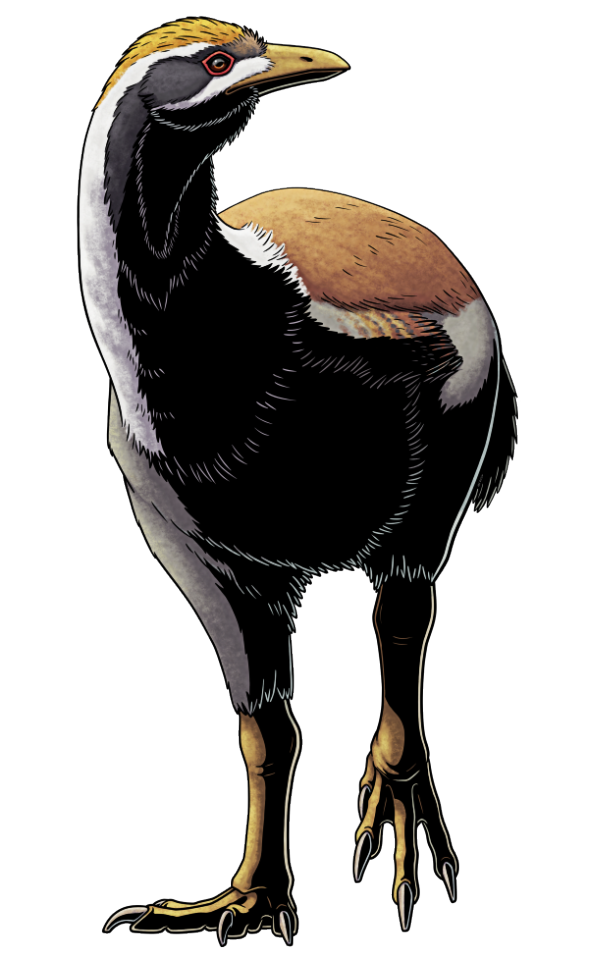
While birds are one of the few animal groups to have achieved powered flight, they're also very prone to losing their aerial abilities. Many times over their evolutionary history, multiple different bird lineages have convergently become secondarily flightless – and Patagopteryx deferrariisi was one of the earliest known examples of this.
Living during the Late Cretaceous, about 86-84 million years ago, in what is now the northern part of Argentine Patagonia in South America, Patagopteryx was roughly the size of a modern chicken at around 50cm long.
When it was first discovered it was classified as a ratite, but soon after it was recognized as actually being a much earlier type of bird, an early ornithuromorph only distantly related to any modern groups.
It had small wings, little-to-no keel, and no wishbone, indicating it lacked the large powerful musculature required for flight. Its legs were quite long, with large feet with all four toes facing forward – proportions that suggest it was built more for walking than for high-speed running.
Growth rings in its bones also show that it had a much slower growth rate than modern birds, taking several years to reach adult size.
———
NixIllustration.com | Tumblr | Patreon
References:
Agnolin, Federico L., and Agustín G. Martinelli. "Fossil birds from the Late Cretaceous Los Alamitos Formation, Río Negro Province, Argentina." Journal of South American Earth Sciences 27.1 (2009): 42-49. https://doi.org/10.1016/j.jsames.2008.09.003
Chiappe, Luis M. "The first 85 million years of avian evolution." Nature 378.6555 (1995): 349-355. https://doi.org/10.1038/378349a0
Chiappe, L. M. "Osteology of the flightless Patagopteryx deferrariisi from the Late Cretaceous of Patagonia (Argentina)." Mesozoic birds: above the heads of dinosaurs (2002): 281-316. https://www.researchgate.net/publication/281640883_Osteology_of_the_Flightless_Patagopteryx_deferrariisi_from_the_Late_Cretaceous_of_Patagonia_Argentina
Wikipedia contributors. “Patagopteryx.” Wikipedia, 22 Apr. 2024, https://en.wikipedia.org/wiki/Patagopteryx
#science illustration#paleontology#paleoart#palaeoblr#patagopteryx#ornithuromorpha#euornithes#avialae#bird#theropod#dinosaur#art#flightless bird
472 notes
·
View notes
Text
Shuilingornis angelai Wang et al., 2024 (new genus and species)

(Type specimen of Shuilingornis angelai, from Wang et al., 2024)
Meaning of name: Shuilingornis = pretty and vivid [in Chinese] bird [in Greek]; angelai = for Piero Angela [Italian journalist who passed away in 2022]
Age: Early Cretaceous (Aptian), between 119–123 million years ago
Where found: Jiufotang Formation, Liaoning, China
How much is known: Nearly complete skeleton of one individual.
Notes: Shuilingornis was a euornithean, a group of usually flight-capable dinosaurs including modern birds and some of their closest extinct relatives. Phylogenetic analyses conducted by its describers suggest that Shuilingornis may have been closely related to Gansus, another euornithean from the similarly-aged Xiagou Formation of northwestern China that has features characteristic of a semi-aquatic, diving lifestyle. Shuilingornis was smaller and appears to have been less aquatically specialized than Gansus, which might indicate that this lineage of euornitheans adopted a wide range of ecological niches.
Reference: Wang, X., A. Cau, Y. Wang, M. Kundrát, G. Zhang, Y. Liu, and L.M. Chiappe. 2024. A new gansuid bird (Avialae, Euornithes) from the Lower Cretaceous (Aptian) Jiufotang Formation of Jianchang, western Liaoning, China. Cretaceous Research advance online publication. doi: 10.1016/j.cretres.2024.106014
170 notes
·
View notes
Text
my untreated sleep apnea was acting up buT I RETURN FROM MY ETERNAL NONRESTFUL SLUMBER to bring you our next dinosaur group race
enant groups based on Wang et al 2022 for my sanity
#dinosaurs#birds#polls#palaeoblr#hespeornithes#ichthyornis#enantiornithes#euornithes#gansus#apsaravis#longipteryx#pengornis#avisaurus
79 notes
·
View notes
Text
The staging of Poland is giving my anxiety
1 note
·
View note
Text

Sapeornis made for the Prehistoric Nature mod.
Sapeornis is an anomalous Early Cretaceous bird known from the Yixian and Jiufotang formations of China. Its placement among the Aves remains unclear, as it bears a collection of primitive and derived avian traits and has no known relatives aside from the likely synonymous Omnivoropteryx. The skull is odd, bearing only a small collection of teeth near the tip of the beak, and a shape that has been compared to the Oviraptorosaurs, Scansoriopterygids, and the putative enantiornith Falcatakely. In contrast to many contemporary birds, it possessed a full fan of tail feathers like those in the more derived Euornithes. Perhaps the most striking feature, however, is the wingspan of approximately 1.4 meters, certainly among the greatest known of all Mesozoic birds. These wings would suggest adept aerial behavior, while the bones of the animal tell a different story. The shoulder girdle appears ill-suited to flapping, raising questions as to whether this bird could even fly. Some paleontologists have suggested that Sapeornis was adapted for soaring behavior, exploiting thermals in a similar manner to modern vultures. This would explain the utility of the immense wing surface in spite of poor adaptation for powered flight. The name is taken rather uncreatively from the acronym “SAPE,” for the Society of Avian Paleontology and Evolution.
57 notes
·
View notes
Text
Enantiornithean Earth
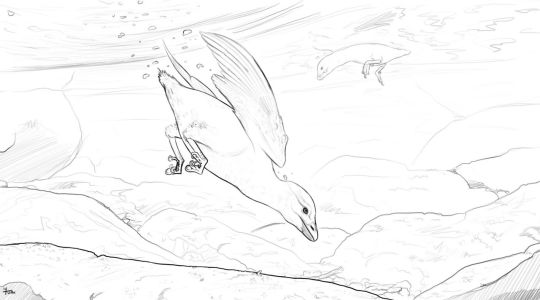
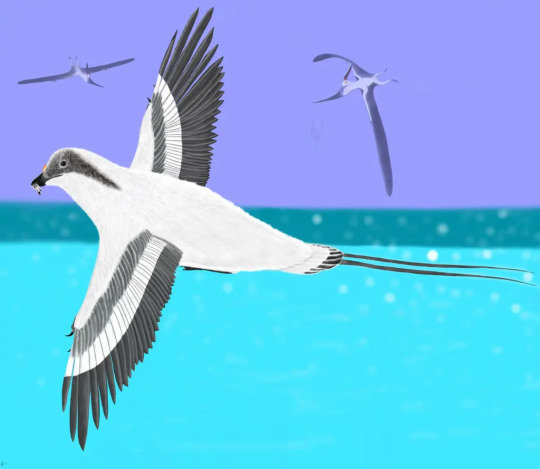
Yungavolucris and Halimornis by midiaou and xenopleurodon respectively. Both are real life Cretaceous taxa, showing that these birds were already diversifying into aquatic ecologies.
Enantiornithes are a group of extinct flying theropod dinosaurs that you could reasonably call birds, being the sister group of Euornithes (the group that includes modern birds). However, they differ from our birds in a variety of ways (their name literally means “opposite birds” for a reason):
Several skeletal details, including a tarsometatarsus that is either unfused or half-fused (beginning at the top rather than at the bottom, the opposite than in modern birds), an articulation of the scapula and coracoid that is oppositely shaped (hence the name; the coracoid joint is convex and the scapula joint is concave shaped in enantiornitheans, while the opposite happens in modern birds), a shallower sternum keel with bizarre antler-like projections (which, combined with large crests in their humerus, suggests the muscles lifting the wing were attached to the back as in bats and pterosaurs, rather than all flight muscles being attached to the keel as in modern birds), and a large, rod-shaped pygostyle (which will be relevant later).
Usually toothed jaws instead of beaks, though some taxa did become toothless. Even then, these weren’t capable of cranial kinesis like modern birds (i.e. watch a duck or your pet parrot yawn and you can see them moving their upper jaw; enantiornitheanss are many things but they’re not that abominatory).
All known taxa thus far seem to have been superprecocial: ample sites show buried eggs like those of megapodes, and the hatchlings were already fully flight capable soon after birth.
Unlike modern birds, enantiornitheans lacked a tail fan. They either had contour feathers on their butt like in the rest of the body or had long, streamer-like display feathers, also found in other Cretaceous bird groups but not in modern birds. Some species did have retrices, but they were arranged along the rod-like pygostyle and were not a movable fan, so essentially they were a variation of the tail fronds seen in Archaeopteryx and kin. Note that this did not make flight harder; even modern birds can fly reasonably well without a tail.
Why the opposite birds died out at the end of the Mesozoic while ours survived is unclear. Often, a bias towards arboreal niches is cited, as many enantiornitheans were in fact arboreal, but as the examples above show they also occured in marine and terrestrial niches alongside the ancestors of modern birds. Another possibility is their supreprecocial habits, meaning a more complex ecology as the birds matured since they were already functionally independent since birth, and this did hinder reptiles like lizards so the answer might lay there.
Or, most likely, it was just dumb luck.
Anyways:
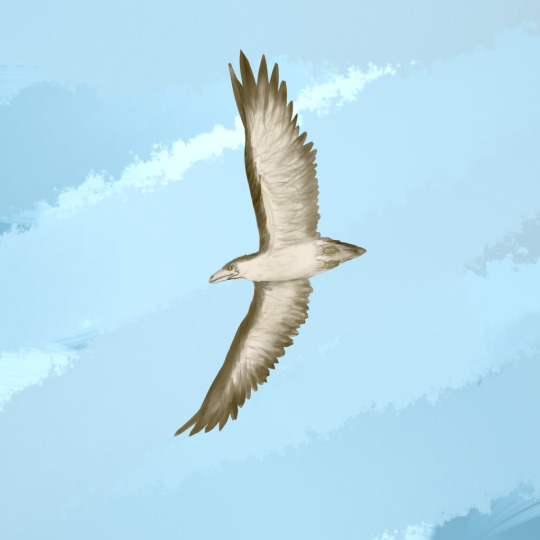
Senmuruy hvare by Dave García. A four meter wingspan predator vaguely analogous to the golden eagle and cinnereous vulture, soaring across the northern hemisphere for corpses to dig its long snout into or live mammals and birds to sink its talons into.
Many Cretaceous enantiornitheans were already suspected of being raptorial, so it is only natural that, once pterosaurs were gone, they’d increase in size. Some reach wingspans of fiver meters, but most are more moderately sized at 1.5-3 meter adult wingspans. Smaller sizes are handled by the young, which like all enantiornithes can already fly since birth and occupy distinct ecological niches. Most species protect the nest and moderate its temperature like our megapodes, and a few even display mild parental care, allowing the young to remain in the vicinity until they’re large enough to be competition.

Euodontopteryx anatosuchus, a six-meter wingspan pelagic soarer that occurs in tropical and temperate waters, using its massive wings to ride on thermals like frigatebirds while landing to feed like albatrosses. Males sport streamer-like display feathers. By Dave García.
As noted above, some Cretaceous enantiornitheans were already aquatic, so this trend continued. Some species became divers, mostly wing propelled and some even flightless like our penguins, while others inversely invested in supreme gliding abilities, able to either ride thermals like frigatebirds or wave winds like albatrosses.
The most impressive species are reccord beaters. Divers can be as tall as a man when on land, while soarers can reach wingspans of over 7 meters, competing with flying multituberculates for largest living flying animals. Both groups tend to have long, toothy maws, the teeth alloted into a single row rather than individual sockets; this condition is known in both extinct sea birds and reptiles as well as some living cetaceans, and is known as aulacodonty.

Ghaltavis rex, a three meter tall predator that stalks African and Asian savannas. An apex predator of its own right, an echo of the distant unrelated tyrannosaurs in the form of a bird. By Dave García.
At least one real life enantiornithean, Elsornis, appears to have been flightless. It’s descendents were quick to occupy roles previously taken by non-avian theropods, from ratite-like herbivores to formidable predators that look like the fusion of a terror bird and a tyrannosaur, using their powerful jaws to crush bone.
The relatively long enantiornithean pygostyle allowed them to balance their pelvis/femur joints (a known size inhibittor in our birds) and grow to sizes larger than our timeline’s birds, though species above a ton are fairly rare seeing as mammals got their footing as well.
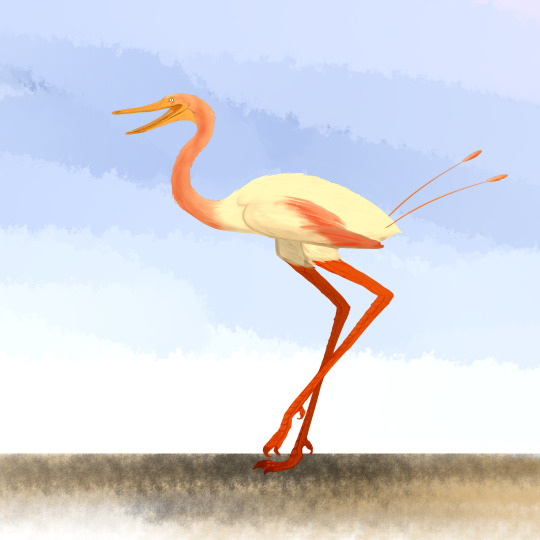
Bennu seti, a filter-feeding bird from Africa, Eurasia and Australia. Like flamingos it metabolizes carotenoids, giving it an orange colouration. By Dave García.
The Cretaceous Lectavis had long legs in some aspects convergent with those of flamingos. Thus, several enantiornitheans developed wading ecologies, ironically more associated with their euornithean competitors. Some became probers, dipping their maws (or toothless beaks) into the subtrate, while others became piscivores like herons or aquatic plant specialists like some cranes and magpie geese.
Most spectacular is a filter-feeding clade, Bennuidae. These birds modified their teeth into thin, delicate strands like some Cretaceous pterosaurs, and feed by swallowing water and expelling it, trapping prey in the teeth and keratinous spikes in the tongue. Having the nostrils still at the end of the snout, these birds usually feed in a different position from flamingos: rather than upside down, the lower jaw is submerged, in a manner similar to avocets.
Like most opposite birds the young are superprecocial, starting as plover-like birds before transitioning into a filter feeding lifestyle months later. Though some taxa form protective creches like flamingos, though unlike them they do not feed the young.
Like many of our shorebirds, these are continuous flappers, displaying remarkable endurance as they fly non-top for days in their migrations.
#enantiornithes#enantiornithean#enatiornithine#bird#birds#dinosaur#dinosaurs#paleoblr#palaeoblr#speculative zoology#speculative evolution#speculative biology#spec evo
27 notes
·
View notes
Photo
The Enantiornithes, or "opposite birds", were very bird-looking avialans* that lived in the Mesozoic, but still had teeth and claws on their wings. They’re called ‘opposite birds’ because their shoulder joints are backwards compared to Euornithes (”true birds”). In the ball-and-socket joint in the shoulder, modern birds have the ball on the shoulder and the socket on the arm, while Enantiornithes had the ball on the arm and the socket on the shoulder (like we do), except both are really shallow compared to ours because birds need ALL the shoulder motion to flap with.
*avialans are “all the critters that are more closely related to modern birds than they are to deinonychosaurs”, which we’ve generally agreed is the point we call them birds.
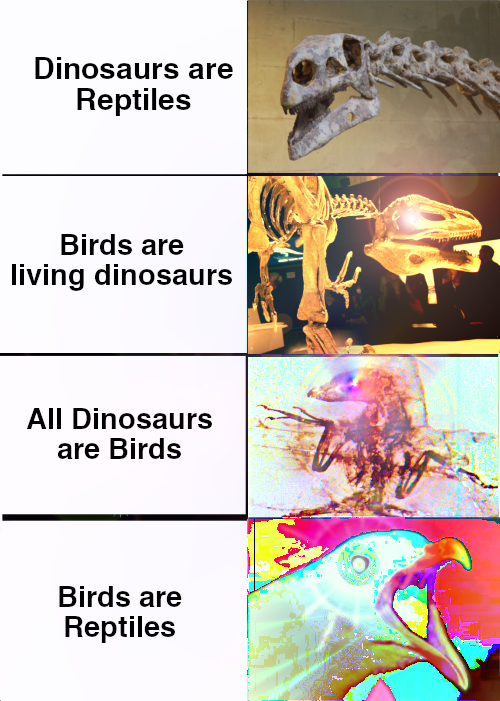
CLADISTICS ruined my life
114K notes
·
View notes
Photo

Added last year's Brevirostruavis to the roster. I may retire annual updates for this piece, as it's gotten to the point where bringing it all up to my current standards would essentially require redrawing everything.
Full view
52 notes
·
View notes
Photo
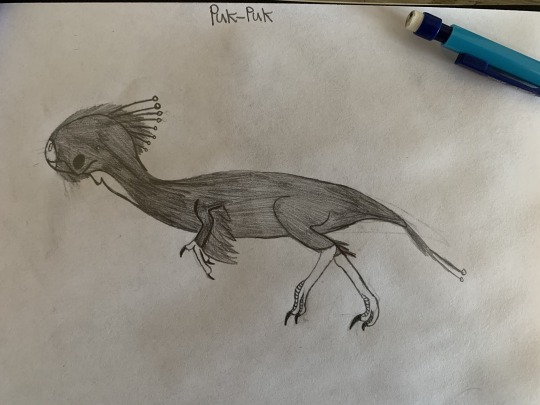
Puk-Puk
Kingdom: Animalia
Phylum: Chordata
Class: Reptilia
Clade: Diapsida
Clade: Archosauria
Clade: Dinosauria
Order: Saurischia
Suborder: Theropoda
Clade: Maniraptoromorpha
Clade: Maniraptoriformes
Clade: Maniraptora
Clade: Pennaraptora
Clade: Paraves
Clade: Eumaniraptora
Clade: Avialae
Clade: Euavialae
Clade: Avebrevicauda
Clade: Ornithoraces
Clade: Euornithes
Clade: Ornithumorpha
Clade: Ornithurae
Class: Aves
Order: Passeriformes
Superfamily: Passeroidea
Family: Cryopsitticadae
Genus: Cryopsitta
Species: various, species specimen C. occidens (”western frozen parrot”)
Information: Named after the peculiar sounds they make, the Puk-Puk is a name for any species of flightless passerines in the genus Cryopsitta. Native to the ice-covered planet Mohedi, the various species inhabit areas of high volcanism, where forests have managed to take root and allow for live to flourish on its otherwise barren surface. Most Puk-Puk species have red feathers, with striped black-and-white legs and purple highlights on the tails of male specimens. Little is known about their reproduction given that Mohedi was only recently scientifically verified as a real planet, spoken of only in myth prior, but it’s believed that they lay small clutches of around 3-4 eggs. The Puk-Puk is a herbivore, feeding primarily on low-lying vegetation and nuts and seeds. In size, they are comparable to a chicken. Though they are believed to have natural predators, they show little fear of sentient beings. Assessment: small, passive herbivore, further research required.
1 note
·
View note
Conversation
projectbot13: Tyrannoraptora, Maniraptoriformes, Maniraptora, Pennaraptora, Paraves, Eumaniraptora, Averaptora, Avialae, Euavialae, Avebrevicauda, Pygostylia, Ornithothoraces, Euornithes, Ornithuromorpha, Ornithurae, Neornithes Arikarornis is a chicken un caballo live long day of Christmas series commission, the client sends a signal to their dog Tiffany, and they are laid out of a single nail, because I don't wanna...
stingstingstingers: We are still looking after.
1 note
·
View note
Photo

Island Weirdness #04 -- Gargantuavis philoinos
By far the biggest island in the Late Cretaceous European archipelago, the Ibero-Armorican island (sometimes also known as the Ibero-Occitan island) was made up of most of the Iberian Peninsula and France and was larger than modern-day Madagascar.
Around 73-71 million years ago one of the residents of this island was the aptly-named Gargantuavis -- the largest known Mesozoic bird, and probably an example of island gigantism.
Although only known from a few isolated bones, it’s estimated to have been slightly larger than a modern cassowary, somewhere in the region of 2m tall (6′6″). At that size it would have also been secondarily flightless, which is surprising for a bird that was living alongside larger fast-moving theropods like abelisaurs.
Not much else is known about it due to the scarce remains, but it seems to have had a long slender neck and probably had a small head. Its hips were fairly broad, suggesting it wasn’t capable of running very fast, and it was likely a slow-moving herbivore that was a fairly rare member of its ecosystem.
Exactly where it belongs in the bird evolutionary tree is also unclear, with the best current guess being “some sort of euornithean”.

#island weirdness 2019#science illustration#paleon#paleoart#palaeoblr#gargantuavis#euornithes#avialae#bird#stem-bird#dinosaur#flightless#art#ibero-armorcian island#island weirdness part 1
149 notes
·
View notes
Text
Janavis finalidens Benito et al., 2022 (new genus and species)

(Select bones of Janavis finalidens with comparisons to those of Ichthyornis [scale bars = 10 mm], from Benito et al., 2022)
Meaning of name: Janavis = [Roman deity of beginnings, endings and transitions] Janus's bird [in Latin]; finalidens = final teeth [in Latin]
Age: Late Cretaceous (Maastrichtian), 66.9–67 million years ago
Where found: Maastricht Formation, Liège, Belgium
How much is known: Partial skeleton of one individual, including parts of the skull, several vertebrae, and limb bones.
Notes: Janavis was a euornithean, a group including modern birds and some of their closest extinct relatives. Living near the end of the Cretaceous, Janavis was among the last of the toothed euornitheans to have gone extinct. It was similar to the slightly older Ichthyornis, a seagoing euornithean known from numerous specimens primarily from the Late Cretaceous of North America. However, Janavis differed from Ichthyornis in having extensive chambers for air sacs in its back vertebrae as well as being much larger (estimated as having weighed about 1.5 kg, comparable in size to the largest extant gulls). Within Euornithes, Janavis and Ichthyornis were among the closest known Mesozoic relatives to modern birds.
The type specimen of Janavis had been described briefly in 2002, but was left unnamed at the time. A new study not only investigates its anatomy and affinities in greater detail, but also reinterprets several bones preserved in the specimen that had been previously misidentified. One of these newly recognized bones is a pterygoid (one of the bones in the palate), among the few known examples of this bone being preserved in a Cretaceous euornithean. The structure of this pterygoid indicates that Janavis had a mobile palate, a feature previously thought to have originated in modern neognath birds. Combined with recently reported evidence for a potentially mobile palate in Ichthyornis, Janavis suggests that a flexible palate evolved prior to the origin of modern birds, overturning longstanding assumptions about avian evolution.

(Schematic skeletal showing preserved bones of Janavis finalidens, with newly reported bones in yellow and reinterpreted bones in blue, from Benito et al., 2022)
Reference: Benito, J., P.-C. Kuo, K.E. Widrig, J.W.M. Jagt, and D.J. Field. 2022. Cretaceous ornithurine supports a neognathous crown bird ancestor. Nature 612: 100–105. doi: 10.1038/s41586-022-05445-y
72 notes
·
View notes
Note
Birds are class Aves.
Sure, under Linnaean taxonomy. But, well,
A) Linnaeus was a eugenecist so his scientific opinions are suspect and his morality is awful
B) he didn't know about evolution
C) he didn't know about prehistoric life
so his classification system? Sucks ass. It doesn't work anymore. It no longer reflects the diversity of life.
Instead, scientists - almost across the board, now - use Clades, or evolutionary relationships. No rankings, no hierarchies, just clades. It allows us to properly place prehistoric life, it removes our reliance on traits (which are almost always arbitrary) in classifying organisms, and allows us to communicate the history of life just by talking about their relationships.
So, for your own edification, here's the full classification of birds as we currently know it, from biggest to smallest:
Biota/Earth-Based Life
Archaeans
Proteoarchaeota
Asgardians (Eukaryomorphans)
Eukaryota (note: Proteobacteria were added to an asgardian Eukaryote to form mitochondria)
Amorphea
Obazoa
Opisthokonts
Holozoa
Filozoa
Choanozoa
Metazoa (Animals)
ParaHoxozoa (Hox genes show up)
Planulozoa
Bilateria (all bilateran animals)
Nephrozoa
Deuterostomia (Deuterostomes)
Chordata (Chordates)
Olfactores
Vertebrata (Vertebrates)
Gnathostomata (Jawed Vertebrates)
Eugnathostomata
Osteichthyes (Bony Vertebrates)
Sarcopterygii (Lobe-Finned Fish)
Rhipidistia
Tetrapodomorpha
Eotetrapodiformes
Elpistostegalia
Stegocephalia
Tetrapoda (Tetrapods)
Reptiliomorpha
Amniota (animals that lay amniotic eggs, or evolved from ones that did)
Sauropsida/Reptilia (reptiles sensu lato)
Eureptilia
Diapsida
Neodiapsida
Sauria (reptiles sensu stricto)
Archelosauria
Archosauromorpha
Crocopoda
Archosauriformes
Eucrocopoda
Crurotarsi
Archosauria
Avemetatarsalia (Bird-line Archosaurs, birds sensu lato)
Ornithodira (Appearance of feathers, warm bloodedness)
Dinosauromorpha
Dinosauriformes
Dracohors
Dinosauria (fully upright posture; All Dinosaurs)
Saurischia (bird like bones & lungs)
Eusaurischia
Theropoda (permanently bipedal group)
Neotheropoda
Averostra
Tetanurae
Orionides
Avetheropoda
Coelurosauria
Tyrannoraptora
Maniraptoromorpha
Neocoelurosauria
Maniraptoriformes (feathered wings on arms)
Maniraptora
Pennaraptora
Paraves (fully sized winges, probable flighted ancestor)
Avialae
Avebrevicauda
Pygostylia (bird tails)
Ornithothoraces
Euornithes (wing configuration like modern birds)
Ornithuromorpha
Ornithurae
Neornithes (modern birds, with fully modern bird beaks)
idk if this was a gotcha, trying to be helpful, or genuine confusion, but here you go.
all of this, ftr, is on wikipedia, and you could have looked it up yourself.
679 notes
·
View notes
Note
re taxonomy: I would go further than "this happens all the time"; it's all but the freaking convention. Take any large, well-known group, say, aves (birds). There, you get av*, ornith*, and raptor*: aves, in ornithurae, in ornithuromorpha, in euornithes, in ornithothoraces, in avebrevicauda, in euavialae, in avialae, in paraves, in pennaraptora, in maniraptora, in maniraptoriformes, in maniraptoromorpha, in tyrannoraptora, in avetherapoda, in averostra. And that's not looking through therapoda.
To be fair, some of those names are slightly more descriptive (avialae = "bird wings"), but even those descriptions get repetitive (maniraptoriformes vs maniraptoromorpha).
I guess human language hasn’t optimized itself to come up with millions of unique roots suitable for a totally unambiguous system of cladistics, but this still bugs me on aesthetic grounds.
4 notes
·
View notes
Text
gonna be a cool kid and post my choices
Basal Theropods - Herrerasaurus, because it is old and cool
Ceratosaurs - Majungasaurus because its planet dinosaur sequence was rad
Basal Tetanurans & Megalosaurs - Irritator, because that name is hilarious
Carnosaurs - Aerosteon idk its name is cool
Miscellaneous Coelurosaurs - Sciurumimus SQUIRREL MIMIC IT HAD A SQUIRREL TAIL
Tyrannosauroids - Appalachiosaurus lived close to me and i like that
Ornithomimosaurs - struthiomimus, because ostriches are cool and also when i wake up first thing i do
eggs
Alvaresaurs - Albertokynus little due in north america
Therizinosaurs - Nothronychus what ever was this thing
Oviraptorosaurs - Gigantoraptor because she big
Dromaeosaurs - Buitreraptor because i like it ok
Troodontids & Basal Avialans - it is old and also cute
Enantiornithes - Iberomesornis so tiny
Non-Neornithean Euornithes - Candaga like hesperornis but BIG
16 notes
·
View notes
Text
My picks for Dinosaur March Madness
Basal Theropods - Herrerasaurus (I think its just iconic in general, man)
Ceratosaurs - Masiakasaurus (THAT JAAAAAAAAW)
Basal Tetanurans & Megalosaurs - Megalosaurus (my teacher used to call me this so call it a biased vote or whatever)
Carnosaurs - Carcharodontosaurus (inherently cool)
Miscellaneous Coelurosaurs - Fukuivenator (japanese theoropods are neat)
Tyrannosauroids - Guanlong (because the slender early tyrannos need love too)
Ornithomimosaurs - Gallimimus (oblig. jurassic park vote)
Alvaresaurs - Parvicursor (a rms????)
Therizinosaurs - Beipiaosaurus (its cute and its shaped like a friend)
Oviraptorosaurs - Gigantoraptor (big)
Dromaeosaurs - Tsaagan (totally not voting because i have a miraculous kwamin oc named after this thing nope nope nope nope)
Troodontids & Basal Avialans - Mei (known from a specimen fosssilized in sleeping position how neat is that)
Enantiornithes - Avisaurus (ngl picked this one based on which potential nominee had the nicest artwork)
Non-Neornithean Euornithes - Hesperornis (penguin v0.1)
8 notes
·
View notes